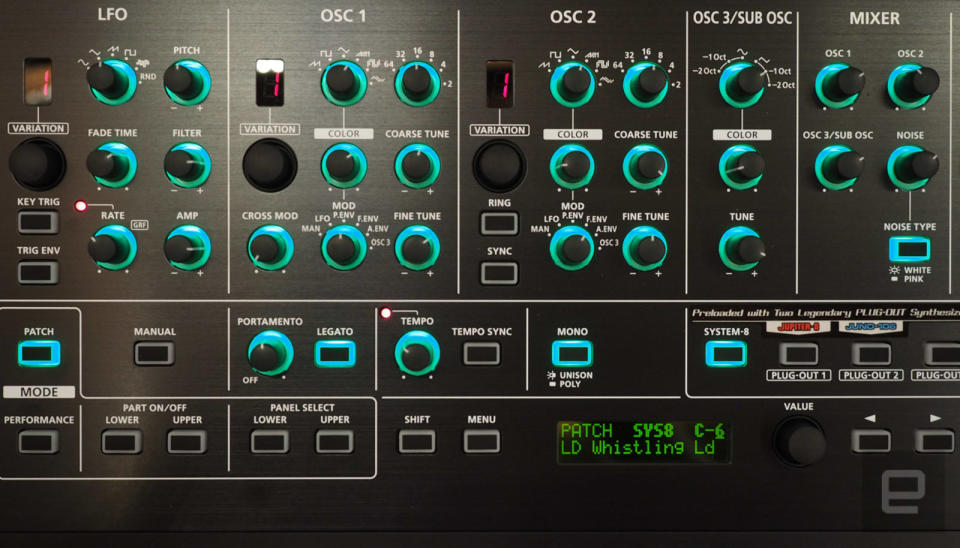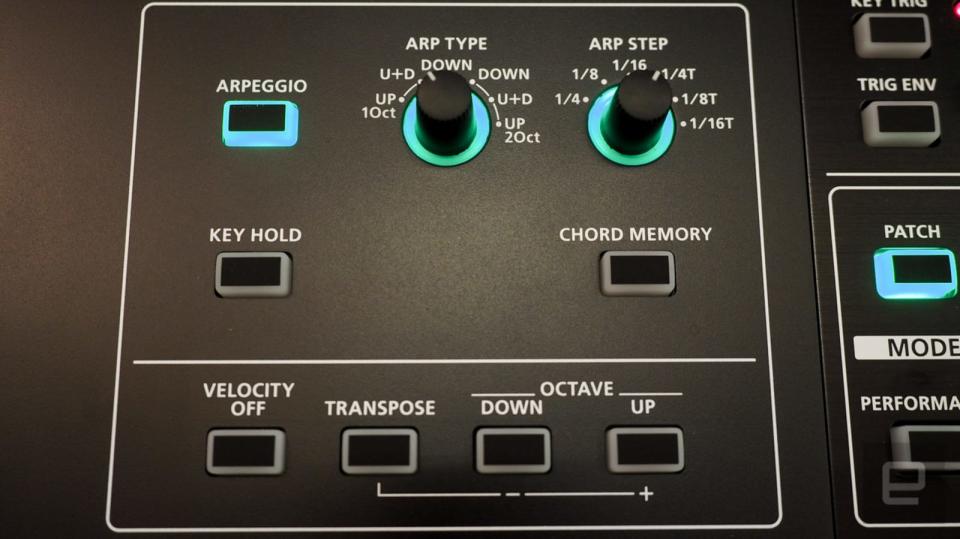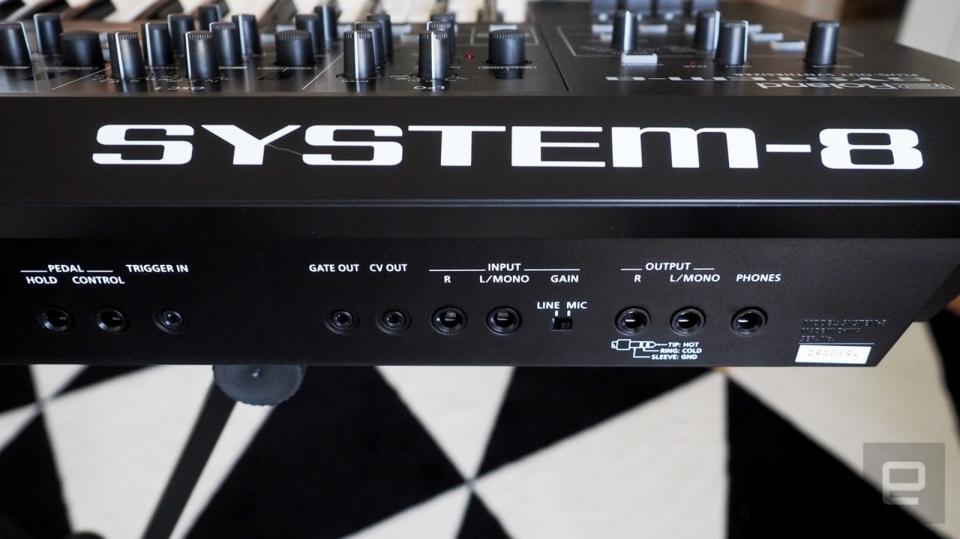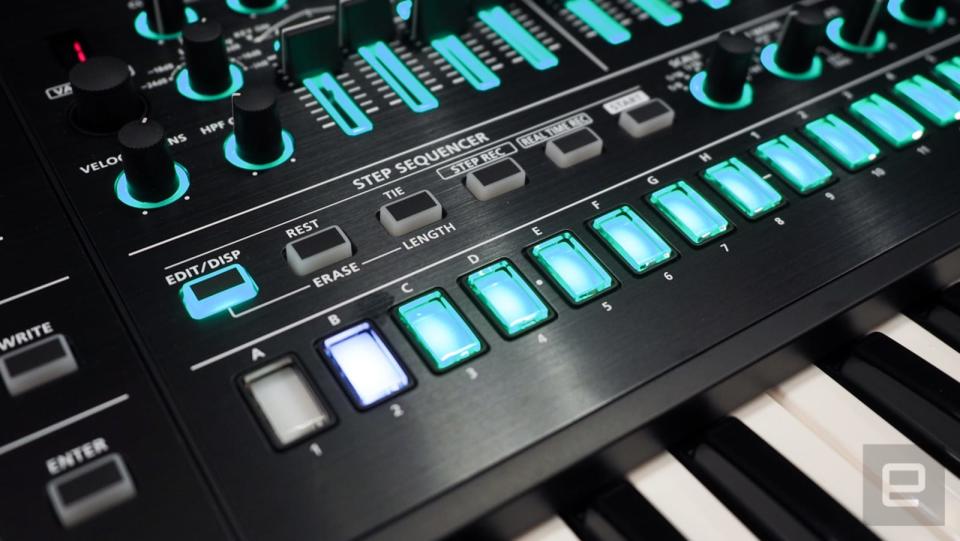Roland's System-8 keyboard is all the synths you want in one case
The company may have just created your favorite synthesizer.

There's a reason professional keyboards and synths are filled with dials, buttons and levers. When a musician is getting ready for the next song, it's quicker to turn a knob than sift through multiple submenus via the onboard computer. Roland's System-8 synth has such a display, but nearly everything you need is at your fingertips, and that's great.
The System-8 continues the company's reputation for aggressively priced drum machines and keyboards modeled after vintage instruments. It even has the same design aesthetic as the Aira family of products that kicked off this nostalgia trend. But don't let those cartoonish glowing green lights distract you from the fact that this is a synth with a ton of features at a great value.
The main draw of the $1,500 System-8 is Roland's "Plug-Out" feature. With it, musicians can add the patches and sounds of old-school synths to the keyboard on the fly. And not just one instrument, either -- three additional Plug-Out synths can be added at a time for quick access via onboard buttons. The sequencer, which on other instruments can be difficult to use, can be ready to record with just a tap. Sequencing a keyboard run is simple. Even when you have to use the onboard display to adjust features like the length of a sequence, it doesn't require a 45-minute dive into the owner's manual.

The synthesizer's push-button "Performance" mode (aka keyboard split, where the high and low-end of the keyboard are split between two different patches) is also just a button-press away. Plus, it can have sounds from two separate Plug-Out synths on it. As a bonus, you can create a sequence for each of those patches. You can even throw in an arpeggiator for good measure, all with a few taps.
In fact, that's the wonderful thing about the eight-voice polyphonic System-8: All the major features are just a tap, twist or slide away. No need to delve into menus and submenus. Touchscreens transformed computing. Without them, we'd still be carrying music players with scroll wheels. But in many instances, they're not a good substitute for physical buttons. (I'm looking at you, automakers.)
Of course, having all those features placed on the top of an instrument could be a confusing mess. Yet Roland has been able to tame the forest of inputs with labeling and placement that make it a snap to change the wave of oscillator one while reducing the volume of oscillator two.

The layout is straightforward, with the arpeggiator on the far left; the oscillators, LFO and associated controls in the middle; and the sequencer and filters on the right. After about five minutes of playing, I knew exactly where to place my hands to adjust the sounds. And if you're worried about those noises, don't be. While analog purists might be turned off by the digital System-8, they'll be hard-pressed to detect the difference between the plug-out Jupiter 8 and the real thing without them playing side by side.
So with a clean, knob-and-button-friendly layout and audio that'll impress even hardcore analog purists, the System-8 is a winner. But it won't be ideal for everyone. First off, the green-glowing lights are likely to be a turnoff for some. I own the Roland Aira TR8, so I've gotten used to it. Fortunately, during my tests, I found that those jade-colored illuminations won't blind you when the lights are down. The last thing you want on stage is something so bright, you can't even see it. That is, if you feel comfortable dragging the System-8 to gigs.

Some might be wary of playing live with the System-8 because of its plastic case. If you plan on using this in your home or practice space, it shouldn't be an issue. But if you want to use it on stage and you play a lot of shows, it could be a problem. You can get a hard case for transportation, but Roland could have gone the extra mile to make the keyboard more robust if it was going to pack it full of features. I would gladly throw the company an extra $150 for a metal or wood case, and I'm sure others would as well.
That's not to say that a plastic case is a recipe for disaster, though. My band has been using a synth on stage with a plastic case for nearly six years without issue. Then again, when it was new it cost about a third of the price of the System-8.

Still, the System-8 is an incredible value at $1,500 -- and it should remind other keyboard makers that it's not just professional-grade products that could use some good old-fashioned knobs to make their instruments easier to use. If you're looking to step up your at-home productions or you're willing to be extra careful while gigging, it'll be a great addition to your synth arsenal.















